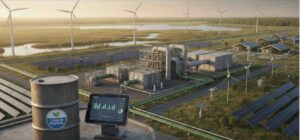The transition to green hydrogen is gaining global momentum as countries and industries look for cleaner energy sources to decarbonize their economies and reduce reliance on fossil fuels. Green hydrogen, produced using renewable energy sources like wind and solar, is seen as a key element in the future energy mix.
Here’s a detailed look at the transition, its importance, challenges, and the strategies driving the adoption of green hydrogen:
1. What is Green Hydrogen?
- Green hydrogen is produced through a process called electrolysis, where water (H₂O) is split into hydrogen (H₂) and oxygen (O₂) using electricity from renewable energy sources. Since the electricity used comes from renewables like wind, solar, or hydropower, the hydrogen produced is considered “green” or carbon-free.
- This distinguishes it from other types of hydrogen:
- Grey hydrogen, produced from natural gas with significant carbon emissions.
- Blue hydrogen, derived from natural gas but with carbon capture and storage (CCS) to reduce emissions.
2. Importance of Green Hydrogen
The transition to green hydrogen is seen as crucial for several reasons:
- Decarbonization of Hard-to-Abate Sectors: Green hydrogen is viewed as the best solution for decarbonizing industries that are difficult to electrify, such as steel manufacturing, chemicals production (e.g., ammonia), and long-haul transportation (aviation, shipping, and heavy trucks).
- Energy Storage: Hydrogen can serve as a form of energy storage, balancing the intermittency of renewable energy sources like wind and solar. It can store excess renewable energy when production exceeds demand and release it when needed.
- Clean Energy Export: Countries rich in renewable energy resources, such as Australia, Chile, and Saudi Arabia, see green hydrogen as a future export commodity. By producing hydrogen from their abundant renewable energy, these countries can export hydrogen to regions with high energy demand but limited renewable resources.
- Energy Security and Diversification: Green hydrogen offers countries a pathway to energy independence, reducing reliance on imported fossil fuels while diversifying their energy mix with sustainable, locally produced hydrogen.
3. Major Green Hydrogen Initiatives and Projects
Several countries and regions are leading the charge in the green hydrogen transition:
- European Union: The EU has a comprehensive Hydrogen Strategy as part of its European Green Deal, aiming to produce 10 million tonnes of renewable hydrogen by 2030. Countries like Germany, France, and Spain are investing heavily in green hydrogen infrastructure, including electrolyzers, hydrogen refueling stations, and pipelines.
- Saudi Arabia’s Neom City: Saudi Arabia is building the world’s largest green hydrogen plant in Neom, a $5 billion project powered entirely by renewable energy from solar and wind. This project is expected to produce 650 tonnes of hydrogen per day by 2025.
- Australia: Australia is positioning itself as a major exporter of green hydrogen, with projects like the Asian Renewable Energy Hub in Western Australia, which aims to produce hydrogen using wind and solar power for export to Asian markets.
- United States: The Biden Administration has committed to developing green hydrogen as part of its climate policy. The Infrastructure Investment and Jobs Act includes significant funding for green hydrogen projects, particularly in heavy industry and transportation.
4. Challenges in Transitioning to Green Hydrogen
While green hydrogen offers tremendous potential, there are several challenges to overcome:
- High Production Costs: Currently, green hydrogen is more expensive to produce than grey or blue hydrogen, largely because renewable energy costs and electrolyzer technology need further development to achieve cost parity. However, with declining costs of solar and wind energy and advances in electrolysis technology, green hydrogen is expected to become cost-competitive within the next decade.
- Infrastructure Development: Hydrogen infrastructure is still in its early stages. Large-scale adoption requires significant investments in new pipelines, refueling stations, storage facilities, and retrofitting existing infrastructure to handle hydrogen.
- Energy Efficiency: Producing green hydrogen through electrolysis and converting it back to electricity or using it in fuel cells involves energy losses. This makes the process less efficient than direct electrification of certain sectors, which is why green hydrogen is mostly targeted at sectors that are difficult to electrify directly.
- Transport and Storage: Hydrogen is difficult to store and transport because of its low energy density in its gaseous state. It requires high pressure, low temperatures, or conversion into other forms (like ammonia) for efficient transport, which increases costs.
5. Strategies to Drive Green Hydrogen Adoption
Governments and industries are taking various steps to accelerate the green hydrogen transition:
- Scaling Up Electrolyzer Capacity: Scaling up electrolyzer production will reduce costs through economies of scale. Several large-scale projects are underway, including Siemens, Iberdrola, and Thyssenkrupp’s plans to build gigawatt-scale electrolyzers.
- Public-Private Partnerships: Many countries are establishing partnerships between governments, energy companies, and research institutions to promote green hydrogen. For example, Germany has formed alliances with countries in North Africa to produce green hydrogen, while Japan is collaborating with Australia on hydrogen imports.
- Subsidies and Incentives: Governments are offering financial support for green hydrogen projects through subsidies, tax breaks, and research grants. For example, the EU Hydrogen Strategy provides funding for R&D and infrastructure development, and the United States is offering incentives for green hydrogen production through its energy policies.
- Hydrogen Valleys: Some regions are developing hydrogen clusters or valleys, where green hydrogen production, distribution, and end-use applications are concentrated in one area. These clusters help integrate hydrogen into local economies while creating job opportunities and driving economic growth.
- Carbon Pricing: Imposing a carbon price or carbon tax on grey hydrogen and other fossil fuels can make green hydrogen more competitive. As carbon pricing becomes more widespread globally, it will further incentivize the shift to clean hydrogen production.
6. Potential Applications of Green Hydrogen
- Industrial Decarbonization: Green hydrogen can replace natural gas and coal in industrial processes, particularly in steel production, cement manufacturing, and chemicals. In steelmaking, for example, hydrogen can be used as a reducing agent instead of carbon, resulting in zero-carbon steel.
- Transportation: Hydrogen fuel cells are a promising solution for decarbonizing sectors like heavy trucking, shipping, and aviation, where battery technology may not be viable due to weight and energy density limitations. Fuel cell electric vehicles (FCEVs) powered by green hydrogen can offer long-range and fast refueling compared to battery electric vehicles (BEVs).
- Power Generation: Hydrogen can be stored and used in gas turbines for electricity generation, providing a flexible, long-term storage solution to balance renewable energy supplies. This allows for a more stable and reliable power grid.
- Residential and Commercial Heating: Green hydrogen can be blended with natural gas or used directly in hydrogen boilers for heating homes and commercial buildings, offering an alternative to electrification in some regions.
7. The Future of Green Hydrogen
The transition to green hydrogen is expected to gain further momentum as production costs decrease, infrastructure expands, and governments intensify their efforts to combat climate change. Some key trends to watch include:
- Cost Reduction: The price of green hydrogen is projected to fall significantly by 2030, with some forecasts predicting it will reach price parity with grey hydrogen in certain regions as early as 2025.
- Global Hydrogen Markets: International hydrogen markets are beginning to form, with countries like Japan, Germany, and South Korea positioning themselves as major importers, while Australia, Chile, and the Middle East focus on becoming leading exporters.
- Technological Innovation: Ongoing R&D in electrolyzer efficiency, hydrogen storage, and fuel cell technology will continue to improve the feasibility of green hydrogen. Innovations in solid oxide electrolyzers and ammonia-to-hydrogen conversion could further expand its use cases.
- Policy and Regulation: Governments are expected to introduce stronger regulations, carbon taxes, and hydrogen-specific policies to incentivize the transition and integrate green hydrogen into national energy plans.
The transition to green hydrogen is a critical step toward a sustainable and carbon-neutral future. While significant challenges remain, advancements in technology, increased investment, and global collaboration are accelerating the shift. Green hydrogen is set to play a pivotal role in decarbonizing industries, powering transportation, and supporting the global energy transition. As costs continue to fall and infrastructure develops, the potential for green hydrogen to reshape the energy landscape will become increasingly apparent.
Read more on Sparkview Energy:
Investing in Renewable Energy: Diversification Strategies for Oil Companies
The Role of Renewable Energy in Achieving Net-Zero Emissions
Sustainable Practices in the Upstream Oil and Gas Sector







